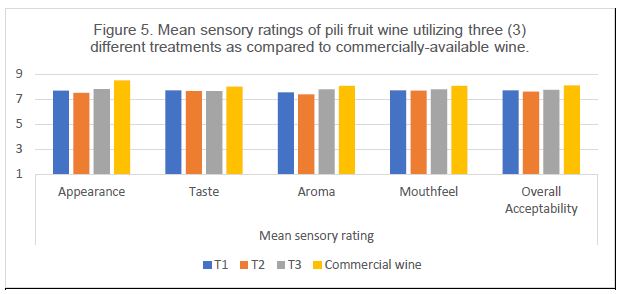Development and Characterization of Pili (Canarium ovatum Engl.) Wine
DOI:
https://doi.org/10.5281/zenodo.11229377Keywords:
pili fruit wine, canarium ovatum engl., physico-chemical characteristics, consumer acceptability levelAbstract
This study aimed to estimate the potential of pili (Canarium ovatum L.) pomace as substrate for the production of fruit wine. The pili fruit wine was characterized in terms of physico-chemical characteristics (pH, TSS and alcohol content) and consumer acceptability level (appearance, taste, aroma, mouthfeel and overall acceptability). It was produced using 5%, 10% and 15% pili pomace as Treatment 1, 2 and 3, respectively. Results showed increase in alcohol content and TSS with increase in concentration of pili pomace while there is decrease in pH as concentration of pili pomace is increased. It was also observed that there is a gradual decrease in total soluble solids and pH and a gradual increase in alcohol content as fermentation time proceeded. Thirty (30) sensory panelists rated pili fruit wine as highly acceptable as commercial wine. Results of the consumer acceptability survey of the pili wine obtained an average rating of 7.71 in overall acceptability which can be interpreted as high liking for the product. Except for appearance, consumer acceptability results of pili fruit wine did not show any significant differences (at 0.05 significance level) in terms of taste, aroma, mouthfeel and overall acceptability when compared to commercial wine.
Downloads
References
Amerine M., Kunkee R., Ough K., Singleton, V., & Webb, A. (1980). The technology of wine making. (4th ed.). Westport.
AOAC. (2012). Official methods of analysis chemist. (19th ed.). Gaithersburg.
Arenas E., & Trinidad T. (2017). Fate of polyphenols in Pili (Canarium ovatum Engl.) pomace after in vitro simulated digestion. Asia Pacific Journal of Tropical Biomedicine, 7(1), 53-58.
Azlan, A., Prasad, K., Khoo, H., Abdul-Aziz, N., Mohamad, A., Ismail, A., & Amom, Z. (2010). Comparison of fatty acids, vitamin E and physicochemical properties of Canarium odontophyllum Miq. (dabai), olive and palm oils. Journal on Food Composition and Analysis, 23(8), 772-776.
Celep, E., Charehsaz, M., Akyuz, S., Acar, E., & Yesilada, E. (2015). Effect of in vitro gastrointestinal digestion on bioavalability of phenolic components and antioxidant potential of Turkish fruit wines. Food International Journal, 78(1), 209-215.
Coronel, R.E. (1996). Pili nut (Canarium ovatum Engl.) promoting the conservation and use of underutilized and neglected crops. Institute of Plant Genetics and Crop Plant Research.
Department of Agriculture-Regional Agriculture and Fisheries Information Division [DA-RAFID 5]. (2011). Pili prospects and potentials. San Agustin, Pili, Camarines Sur: Agriculture Marketing Assistance Division, Department of Agriculture RFU 5.
Gasteineau, F., Darby, J., & Turner, T. (1970). Fermented food beverages in nutrition. Academic Press.
Jackson, R. (2000). Principles, wine practice science perception. Academic Press.
Joshi, V. (1995). Fruit wines. DYS Parmer University of Horticulture and Forestry.
Kakuda, Y. (2000). Characterization of pili nut (Canarium ovatum) oil: Fatty acid and triglycerol composition and physicochemical properties. Journal of the American Oil Chemists’ Society, 77(1), 991-996.
Millena, C., & Sagum, R. (2018). Physico-chemical characterization and fatty acid profiling of different Philippine Pili nut (Canarium ovatum, Engl.) varieties. American Oil Chemists’ Society.
Orolfo, E. (2000). Assessment of the pili industry in the Bicol region. Paper presented in the Crop Congress, Agri-Fiesta Sa Bikol 2000, Naga City.
Pham, L., & Dumandan, N. (2015). Philippine pili: Composition of the lipid molecular species. Journal of Ethnic Foods, 2(4), 147-153.
Segura, R. (2008). Other relevant components of nuts: phytosterols, folate and minerals. British Journal of Nutrition, 96(2), 447-448.
Zarinah, Z. (2014). Extraction and determination of physico-chemical characteristics of pili nut oil. International Food Research Journal, 21(1), 297-301.
Zeppa, G. (2007). The science and technology of wine making. Science and Technology Journal, 1(2), 214.

Downloads
Published
How to Cite
Issue
Section
ARK
License
Copyright (c) 2024 Robelle M. Tapado

This work is licensed under a Creative Commons Attribution 4.0 International License.
Research Articles in 'Applied Science and Biotechnology Journal for Advanced Research' are Open Access articles published under the Creative Commons CC BY License Creative Commons Attribution 4.0 International License http://creativecommons.org/licenses/by/4.0/. This license allows you to share – copy and redistribute the material in any medium or format. Adapt – remix, transform, and build upon the material for any purpose, even commercially.










